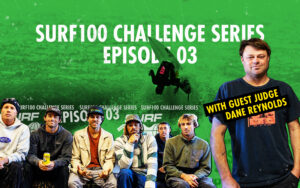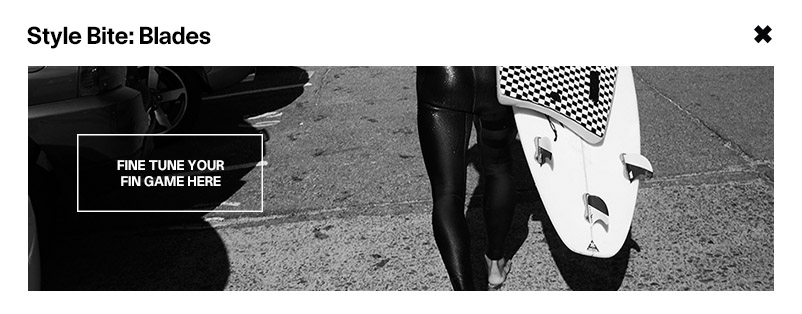Fin tech for the everyman, with Ryan Callinan
Surfing’s a tech nerd’s dream. There’s so many little adjustments in equipment that can lead to an increase in performance and fun factor. But it’s also important to remember how strong the placebo effect is in surfers, for better or ill. Fins really get the surf geeks salivating! You’ll hear them out in the surf talking about changing their fins and using words that you (and most likely, they) don’t understand. Here’s Ryan Callinan’s intel you need to know about those sharp things that are screwed to the bottom of your surfboard. Plus, the lingo to piece it all together. Words by Ryan Callinan | Photo by Woody Gooch I’m quite a tall and bigger guy (6’1” and 78kg) guy and I like big fins. I push hard in my turns therefore I need something that holds in well, both in the manoeuvre, and off the bottom. At the same time, they need to have good release for when I’m going off the lip. I’m currently swapping between Kinetic Racing’s Parko fin, and Al Merrick’s large fins. I have one rule: Use the same fin in all of your boards. If you keep swapping fins for every different board it’s hard to tell how boards actually go compared to each other. Once you have your boards super dialled, then you can start experimenting, but for me I like to take out as many variables as possible when finding a good board. If I know the way a fin works, that’s one less thing to worry about when deciding if the board is good compared to the last one. I don’t test different fins too frequently, maybe three times a year. If I do test, it’s because I’ve seen a lot of other people, who’s surfing I admire, using different fins. Recently I just started trying FCS 2, instead of Futures, and I had to test a few of them to see which went best. Turned out Al Merrick’s Large was my fav. It can help trying new fins, for sure. You just have to know what you like and find fins which have a similar shape to what you’re used to. I’m sure if you asked 10 different people about fins you would get different answers. Everyone is unique and has there own views on them and how they go. My way of thinking is pretty old school; do what you know, don’t change things too much. But it works for me, and consistency will improve your surfing. Template. This is the general outline shape of the fin. Duh. Sweep\Rake. This is how much the fin’s outline shape is curved backward. Think hair. It’ll directly affect how your board turns. More sweep equals longer turning arc. Less sweep, top to bottom madness. Depth. Like a pool, this is how far that blade of yours is knifing into clean walls. The shorter the depth the more sliding capabilities your craft’ll have. More depth will hold in better on larger walls. Base. The length of the fin where it meets the board. Base and drive are hot for each other. Generally the more base the more area the fin has to push against the water and therefore the more drive, aka, the more of your weight you can put into each turn without bogging. But, it’s all relative. A shitty wave that doesn’t allow you to squirt those kilos is going to make your board feel lifeless. Other vital terms that you absolutely don’t have to know about: Flex. The amount of flexibility from the straight position. Stiff fins are more responsive and will have more speed and direct drive. Fins with flex are more forgiving and easier to use, great for gutless beach breaks. Ideally a fin would have a stiffer base and a more flexible tip for release in this modern age. Cant. The angle of the fin leaning out from the bottom of the board towards the rail. More cant is a more responsive board through a turn, less cant will be faster, especially down the line on a point break. Foil. See how those two fins on the side have one curved edge on the outside? And the one in the middle has two cured sides like an aeroplane wing? Meet foil. It’s damn important too, because it affects how the water flows underneath and can lift the board. But it’s a juggling act. Because too much foil is going to drag your craft like leaving on the handbrake.
Surfing’s a tech nerd’s dream. There’s so many little adjustments in equipment that can lead to an increase in performance and fun factor. But it’s also important to remember how strong the placebo effect is in surfers, for better or ill. Fins really get the surf geeks salivating! You’ll hear them out in the surf talking about changing their fins and using words that you (and most likely, they) don’t understand. Here’s Ryan Callinan’s intel you need to know about those sharp things that are screwed to the bottom of your surfboard. Plus, the lingo to piece it all together.
Words by Ryan Callinan | Photo by Woody Gooch
I’m quite a tall and bigger guy (6’1” and 78kg) guy and I like big fins. I push hard in my turns therefore I need something that holds in well, both in the manoeuvre, and off the bottom. At the same time, they need to have good release for when I’m going off the lip. I’m currently swapping between Kinetic Racing’s Parko fin, and Al Merrick’s large fins.
I have one rule: Use the same fin in all of your boards. If you keep swapping fins for every different board it’s hard to tell how boards actually go compared to each other. Once you have your boards super dialled, then you can start experimenting, but for me I like to take out as many variables as possible when finding a good board. If I know the way a fin works, that’s one less thing to worry about when deciding if the board is good compared to the last one.
I don’t test different fins too frequently, maybe three times a year. If I do test, it’s because I’ve seen a lot of other people, who’s surfing I admire, using different fins. Recently I just started trying FCS 2, instead of Futures, and I had to test a few of them to see which went best. Turned out Al Merrick’s Large was my fav. It can help trying new fins, for sure.
You just have to know what you like and find fins which have a similar shape to what you’re used to.
I’m sure if you asked 10 different people about fins you would get different answers. Everyone is unique and has there own views on them and how they go. My way of thinking is pretty old school; do what you know, don’t change things too much. But it works for me, and consistency will improve your surfing.
Template. This is the general outline shape of the fin. Duh.
Sweep\Rake. This is how much the fin’s outline shape is curved backward. Think hair. It’ll directly affect how your board turns. More sweep equals longer turning arc. Less sweep, top to bottom madness.
Depth. Like a pool, this is how far that blade of yours is knifing into clean walls. The shorter the depth the more sliding capabilities your craft’ll have. More depth will hold in better on larger walls.
Base. The length of the fin where it meets the board. Base and drive are hot for each other. Generally the more base the more area the fin has to push against the water and therefore the more drive, aka, the more of your weight you can put into each turn without bogging. But, it’s all relative. A shitty wave that doesn’t allow you to squirt those kilos is going to make your board feel lifeless.
Other vital terms that you absolutely don’t have to know about:
Flex. The amount of flexibility from the straight position. Stiff fins are more responsive and will have more speed and direct drive. Fins with flex are more forgiving and easier to use, great for gutless beach breaks. Ideally a fin would have a stiffer base and a more flexible tip for release in this modern age.
Cant. The angle of the fin leaning out from the bottom of the board towards the rail. More cant is a more responsive board through a turn, less cant will be faster, especially down the line on a point break.
Foil. See how those two fins on the side have one curved edge on the outside? And the one in the middle has two cured sides like an aeroplane wing? Meet foil. It’s damn important too, because it affects how the water flows underneath and can lift the board. But it’s a juggling act. Because too much foil is going to drag your craft like leaving on the handbrake.















Comments
Comments are a Stab Premium feature. Gotta join to talk shop.
Already a member? Sign In
Want to join? Sign Up